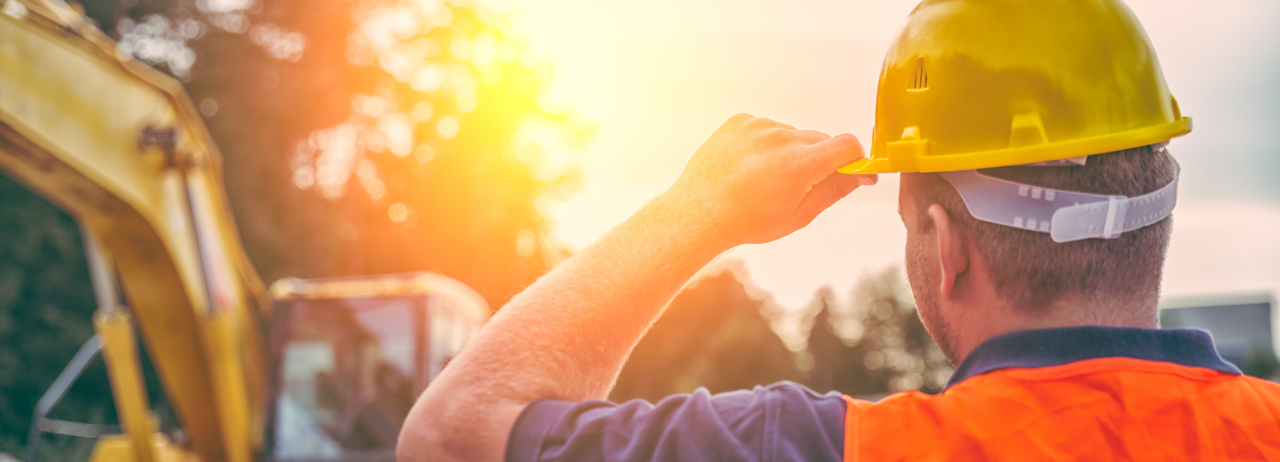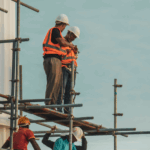The Overlooked Essentials of UV Protection
Outdoor workers face more than just the heat; they deal with UV-A and UV-B radiation that can cause skin cancer, accelerated aging, and eye damage over time. To properly protect employees, employers must implement engineering and administrative controls alongside PPE, not just rely on sunscreen. Here’s how to build a comprehensive UV safety strategy:
1.Engineering Controls: Shielding Workers from UV at the Source
Shade Structures and UV Barriers
Installing portable shade canopies, covered rest areas, or using natural shading are effective ways to reduce direct UV exposure. In vehicle-heavy jobsites, window tinting with UV-absorbing films can reduce interior exposure significantly. These methods align with OSHA’s recommendations to reduce environmental hazards using controls rather than relying solely on PPE.
For long-term job sites, it’s worth incorporating UV barriers like treated mesh, awnings, or site-designed shelters into the site layout. Clarion Safety Systems provides helpful guidance on workplace UV risk management, especially for crews exposed for extended hours.
Enclosures and UV Filtering Systems
For indoor operations involving artificial UV sources, such as curing lights, UV sanitation systems, or welding, employers must install enclosures and shielding to prevent stray radiation. Materials like polycarbonate or metal barriers can effectively block UV-C wavelengths. The University of Nevada, Reno’s Radiation Safety Office outlines specific requirements for shielding and signage in these environments.
These measures fall under the Hierarchy of Controls, a framework promoted by the National Institute for Occupational Safety and Health (NIOSH). Engineering controls are ranked near the top, just below elimination and substitution, because they reduce exposure at the source, protecting all workers, not just those who wear PPE correctly or remember to apply sunscreen.
Why It Matters: Engineering controls are considered higher up in the hierarchy of hazard control. They’re more reliable than behavior-based solutions because they protect everyone by minimizing exposure automatically.
2.PPE Standards: Specifying UV-Rated Safety Gear
High‑Visibility, UV‑Rated Apparel
Many employers require ANSI/ISEA 107-compliant gear for visibility, but not all high-visibility clothing offers UV protection. That’s a key oversight. When possible, opt for apparel that meets both standards: visibility and ultraviolet protection factor (UPF) ratings of 40 or higher.
Clothing should meet sun protective fabric standards such as EN 13758-2 in Europe and ASTM D6603 in the United States, which define labeling requirements and testing methods for UV-protective garments. These standards ensure that clothing labeled with a UV protection factor (UPF) has been properly evaluated for its effectiveness in blocking ultraviolet radiation. According to the Skin Cancer Foundation, a UPF rating of 50 blocks 98% of UV rays, significantly reducing skin cancer risk for outdoor workers.
Face and Eye Protection for UV Sources
In welding and light-curing tasks, face shields and goggles must meet ANSI Z87.1 standards for optical radiation and impact protection. Selecting the correct filter shade number for the task ensures adequate eye protection based on exposure levels. OSHA includes specific requirements for these tasks under 29 CFR 1910.133.
3.Standards Integration and Program Implementation
Site hazard assessments should document both natural and artificial UV exposure risks. Identify areas that lack shade, tasks performed during peak sunlight hours, and roles involving equipment that emits UV-C. This information informs not just PPE decisions, but also engineering controls and break policies.
Build a PPE Policy Around UV Exposure
Develop a formal UV section in your PPE program that includes:
- Approved UV-rated clothing and eyewear specs
- Maintenance and replacement schedules
- Seasonal guidance (e.g., summer re-emphasis)
- Vendor-approved product lists
Educate the Workforce
Effective UV safety isn’t just about handing out gear—it requires training on proper use, inspection, and limitations. Your team should understand:
- How to read UPF labels
- How to check for wear or UV damage in clothing and face shields
- Why sunscreen alone is not enough
Incorporate UV topics into toolbox talks during the summer months or at project kickoff.
Routine Auditing
Field audits should assess:
- Shade availability and utilization
- Compliance with high-visibility and UPF-rated clothing
- Use of eye and face protection in high-exposure areas
- Sunscreen and hydration availability
These findings can be documented in a platform like LinkSuite, allowing for better tracking and corrective action planning.
In summary, building a layered UV safety program requires more than sunscreen reminders. It demands a thoughtful mix of engineering controls, appropriate PPE, and policy enforcement. For companies serious about worker protection, this multi-level approach strengthens safety culture AND shields employees from long-term harm.
Committing to Long-Term Protection
UV exposure may not cause immediate injuries like slips or falls, but its effects are cumulative and just as serious. As safety leaders, it’s critical to address both visible and invisible risks by implementing a layered strategy: engineering controls, proper PPE, thoughtful scheduling, and ongoing education.
At Pearson Safety Solutions, we help businesses build safer workplaces through proactive planning, up-to-date compliance support, and hands-on training. Whether you’re managing a large jobsite or a small outdoor crew, we’re here to support your safety goals every step of the way.
Looking to strengthen your safety program? Contact us at info@personsafety.com to explore our construction safety training offerings here or contact us to schedule a jobsite consultation.



